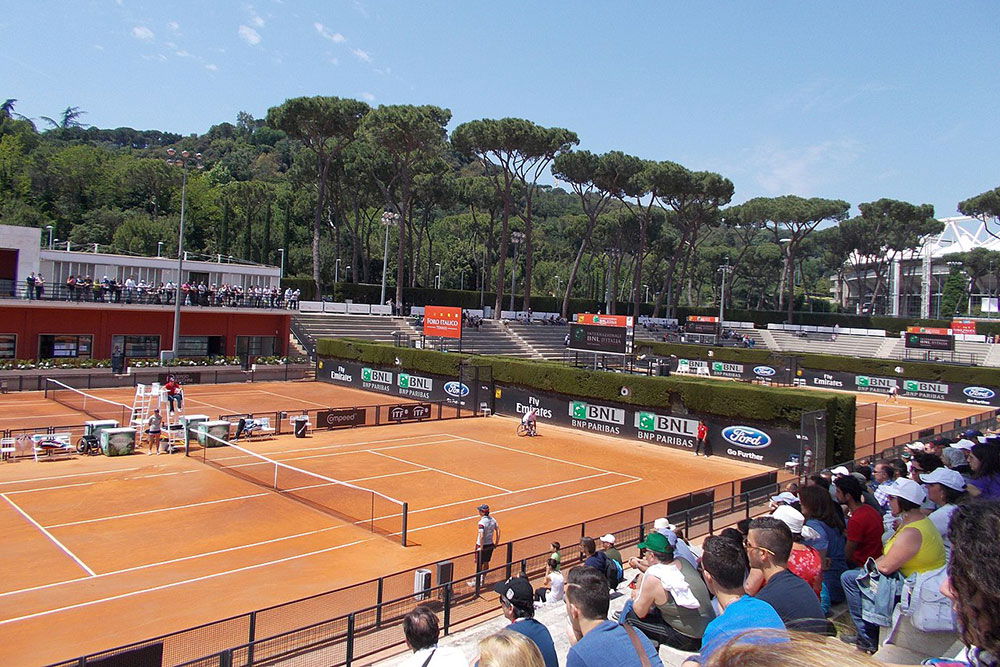
Nestled at the foot of Monte Mario along the banks of the Tiber River, Foro Italico is one of Rome’s most intriguing and grandiose architectural spaces. Originally conceived as a Fascist showpiece in the 1920s and 1930s, it has since evolved into Italy’s national hub for elite sports, housing facilities for football, tennis, swimming, and athletics, and serving as a cultural landmark at the intersection of architecture, ideology, and sporting history.
Today, the complex is best known for hosting the Internazionali BNL d’Italia, one of the world’s premier clay court tennis tournaments, but its story stretches far beyond athletic contests. Foro Italico is both a celebration of sport and a monument to a controversial era, echoing Italy's 20th-century history in travertine and marble.
Foro Italico was conceived in 1928 under the Fascist regime of Benito Mussolini, originally named Foro Mussolini. The regime aimed to create a modern equivalent of the Roman Forum, a vast complex to promote youth, vitality, and physical fitness, and showcase the greatness of the Fascist state through architecture and public spectacle.
The project was driven by architect and engineer Enrico Del Debbio, with later contributions by Luigi Moretti. Inspired by ancient Roman forums, the complex was designed to glorify Mussolini’s vision of a rejuvenated Italy, a fusion of classical proportions and modern power.
In its original conception, the Foro Mussolini included monumental features such as:
The Stadio dei Marmi (Stadium of the Marbles): A neoclassical stadium surrounded by 60 marble statues of athletes, each donated by Italian provinces.
The Obelisk of Mussolini: A 17.4-meter monolith inscribed with "MUSSOLINI DUX," still standing today despite decades of debate.
Avenue of the Statues: A wide, processional boulevard flanked by sculptures and geometrically patterned black-and-white mosaics celebrating sport and Fascist ideology.
Despite its propagandistic intentions, the complex's enduring beauty and grandeur have made it a vital part of Rome’s sporting life.
After World War II and the fall of the Fascist regime, the complex was renamed Foro Italico to reflect a new national identity free of overt political associations. While the obelisk and many architectural elements remained, Italy began using the space to host a new kind of grandeur, international sport, open culture, and civic pride.
A key moment in the site’s evolution was its selection as the central venue for the 1960 Rome Olympics, marking Italy’s reemergence on the world stage. The Olympics led to the construction and modernization of several major facilities within the complex.
The centerpiece of the complex, the Stadio Olimpico is the home of both AS Roma and SS Lazio, Rome’s two major football clubs. It also serves as Italy’s national stadium for international football and rugby matches.
Capacity: Around 70,000
Opened: 1953 (rebuilt for the 1960 Olympics)
Notable events: 1960 Olympic Games, 1990 FIFA World Cup, 2009 UEFA Champions League Final, Six Nations Rugby
Perhaps the most unique structure in the complex, this stadium is surrounded by statues representing idealized male athletes in classical poses. It is primarily used for youth sports and training but remains a major draw for tourists and photographers due to its striking appearance.
Foro Italico is the annual host of the Internazionali BNL d’Italia, a prestigious ATP and WTA clay court tennis event that draws top global talent like Novak Djokovic, Rafael Nadal, and Iga Świątek. The Centrale Court, opened in 2010, is a sleek modern venue that blends harmoniously with the historical surroundings.
The Piscina delle Rose and other aquatic facilities were central to the 1960 Olympics and remain in use today for both competitive and recreational swimming. Indoor venues accommodate sports such as volleyball, fencing, and gymnastics.
While many Fascist-era monuments in Italy have been demolished or altered, Foro Italico remains one of the most intact and visible examples of Fascist architecture in Europe. Its stark lines, grand scale, and use of symbolism reflect the ideology of the time.
Visitors often marvel at the black-and-white mosaics in geometric and symbolic patterns, the towering obelisk, and the Avenue of the Statues. Though politically charged, these artistic and architectural expressions are part of a larger conversation about how history is preserved and interpreted in public spaces.
The balance between honoring the past and rejecting its darkest chapters continues to provoke debate. The site is often used in academic discussions on architectural ethics, memory, and the repurposing of politically sensitive spaces.
Today, Foro Italico is not a relic but a living, breathing sports hub. Throughout the year, it hosts:
Internazionali BNL d’Italia (Rome Masters)
Serie A football matches (Roma and Lazio)
Six Nations rugby
Concerts and large public events
University sports programs (home to Università di Roma Foro Italico, Italy’s only sports science university)
The area around the complex includes cafes, green spaces, and open areas for jogging and cycling, making it a lively destination even outside of major events.
Location: Northern Rome, near the Vatican and Monte Mario
Transport: Easily accessible via Tram 2, buses, and taxis; limited parking on event days
Tours: While not always open for general tours, many guided experiences include visits to Stadio dei Marmi and Stadio Olimpico
Best Time to Visit: During the tennis tournament in May, the football season, or spring/summer for open-air events and architecture walks
Foro Italico is more than just a sports complex, it is a narrative carved in marble, blending the drama of athletic competition with the bold lines of historical architecture. From its controversial birth under Fascism to its rebirth as a hub for modern sport, the complex continues to reflect the spirit of Italy: passionate, contradictory, historic, and constantly evolving.
Whether you’re a fan of football, a lover of tennis, an architecture enthusiast, or a curious traveler, Foro Italico offers a unique and unforgettable perspective on Rome, where past and present collide in the arena of human performance.

More Details